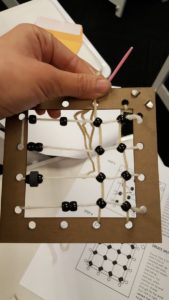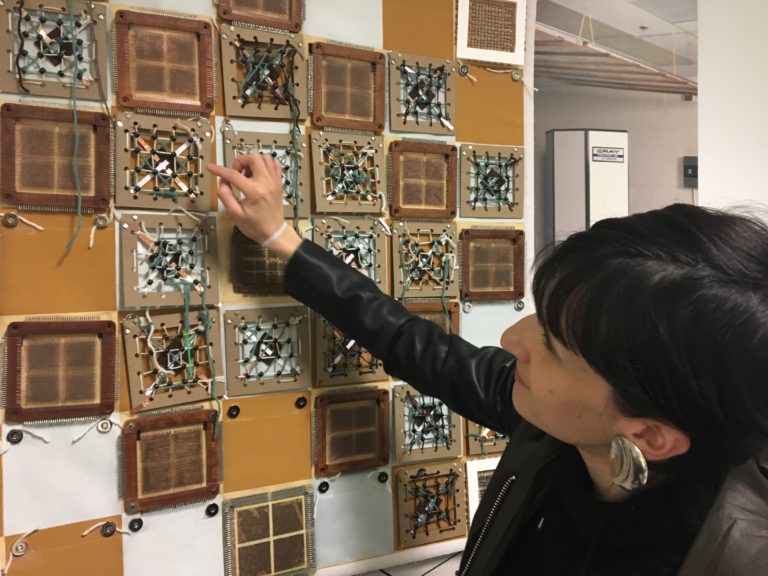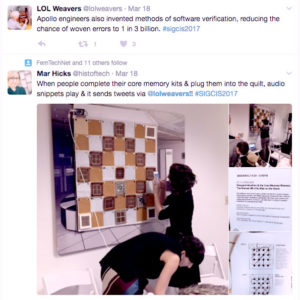Converge: Disciplinarities and Digital Scholarship encourages design educators, design researchers, and designers to take advantage of opportunities in digital scholarship, learn how to collaborate on interdisciplinary projects, and find new intersections within their existing research trajectories. To redefine what it means to be a designer and a design researcher today, we ask: How can design converge with digital scholarship in more than a superficial way? How might aspects of digital scholarship impact design research? What are the key questions at the intersection of design and the humanities?
This conference took place June 1-3, 2017 in Los Angeles, CA.
Keynote Speakers
Johanna Drucker
Breslauer Professor of Bibliographical Studies, Department of Information Studies, UCLA
Casey Reas
Professor, UCLA Design Media Arts, and Co-Founder, Processing
Erik Loyer
Creative Director, The Alliance for Networking Visual Culture
Conference Location
School of Cinematic Arts (SCA)
University of Southern California
900 West 34th Street
Los Angeles, CA 90089-2211
Connect
converge.aiga.org
converge.aiga@gmail.com
facebook.com/groups/AIGAConverge
twitter.com/aiga_converge
#aigaconverge
Organizing Committee
Jessica Barness
Associate Professor, School of Visual Communication Design, Kent State University
Her research resides at the intersection of design, humanistic inquiry, and interactive systems, investigated through a critical, practice-based approach. She has presented and exhibited her work internationally, and has published research in Design and Culture, Dialectic, Visual Communication, and Message, among others. She recently co-edited a special issue of the journal Visible Language with Amy Papaelias entitled “Critical Making: Design and the Digital Humanities” (2015).
Vicki Callahan
Associate Professor, School of Cinematic Arts, at the University of Southern California.
Her research and teaching is focused on the integration of theory and practice with attention to issues in film and media history, feminist studies, digital culture, media strategies for social change, and public scholarship. She was an NEH fellow for the inaugural workshop, “Scholarship in Sound and Image,” on Videographic Criticism at Middlebury College, and in 2015 she was in residence at University College Cork, Ireland as a Fulbright Scholar with a focus on digital media praxis.
Heather Corcoran
Director, College and Graduate School of Art; Professor, Design, Washington University in St. Louis
Her work explores relationships between information and expression in collaborative projects for social impact and self-generated projects for exhibition. She was lead author on the article “Making cancer surveillance data more accessible for the public through Dataspark,” published in Visible Language in 2013, and co-principal investigator on a grant funded by the National Cancer Institute (NIH), 2009-11. An exhibition of her work, Reading Time: Visual Timelines, Texts, and Canons, opened at Gallery 360 at Northeastern University in Boston in 2014.
Sarah Lowe
Professor, Graphic Design, University of Tennessee
Her work across technology, cultural heritage and museum studies researching the design of digital engagement with the public has led to research partnerships with The National Park Service, The US Holocaust Museum, and the Eastern Band of the Cherokee Nation. Her work has been presented at CUMULUS, NORDES and the Museum Computer Network (MCN) in addition to several DEC conferences. In 2012/13 she was a Fulbright Scholar at the University of Oslo, Norway, researching the design of educational technologies in relation to learning theory.
Amy Papaelias
Assistant Professor, Graphic Design, SUNY New Paltz
She has presented her design research and pedagogy at Theorizing the Web, the Type Directors Club, NYC DH Week, TypeCon, and other DEC conferences. In 2013, Amy participated in One Week One Tool, an NEH-funded Institute for Advanced Topics in the Digital Humanities. She co-edited a special issue of the journal Visible Language with Jessica Barness entitled “Critical Making: Design and the Digital Humanities” (2015). She is a founding member of Alphabettes.org.
Holly Willis
Chair, Media Arts + Practice, School of Cinematic Arts, University of Southern California
Former DEC Steering Committee co-chair, Holly works at the intersection of cinema, design, media literacy and the humanities. She co-founded and launched the practice-based Media Arts + Practice program integrating design research and critical theory/making, and is currently involved with USC’s Mellon-funded Digital Humanities Program supporting humanists in manifesting their research through media-rich experiences. She has helped organize and has presented at many previous DEC conferences, including New Contexts/New Practices, Schools of Thought III and NEXT
SPONSORS
USC School of Cinematic Arts
Washington University in St. Louis
Kent State University: College of Communication and Information, School of Information, School of Visual Communication and Design
Browse the Converge: Disciplinarities and Digital Scholarship Collections
Modes: Multi-sensory Media Experience for Stress-Reduction
06/02/2017Emily Verba Fischer, University of Cincinnati
John Hebbeler, University of CincinnatiIn societies where productivity is prioritized over presence, stress abounds. The extensive and alarming effects of stress on the mental and physiological wellbeing of college students inspired a cross-disciplinary team to tackle this problem using their combined expertise in visual design, music technology, psychology, art therapy, and mindfulness. The Modes experience is an atmospheric, introspective, and aesthetically sophisticated engagement of three senses: ophthalmoception (sight), audioception (hearing), and tactioception (touch). Through immersive interaction, mesmerizing visual and aural landscapes are generated in order to reduce stress in college students while simultaneously entertaining them. The two measurable outcomes of Modes are (1) the reduction of the stress hormone cortisol in users, and (2) the reduction of user heart rates.
The design and functionality of Modes are rooted in tenets of mindfulness practice and Ayurveda — an ancient Indian healing system emphasizing inner balance as a method for maintaining health and wellness. Interacting with Modes is like playing in a sandbox of dynamic visuals and sounds. Users begin by selecting and entering one of three digital environments, each offering a unique mindfulness practice designed specifically for stress reduction. A recent scientific study proved that mindfulness practice reduced overall mean diurnal cortisol in test subjects. In this study, cortisol levels were measured and assessed using a saliva collection tool. There is reason to believe that the same saliva test (to be performed in June, 2017) will prove Modes successful in reducing the stress hormone cortisol in users.
Emily Verba Fischer is a designer, educator, and researcher. She has been a faculty member in the School of Design at the University of Cincinnati since 2011, where she primarily teaches information design, typography, motion design, and design methodology. An Ohio native, Emily returned to the Midwest after receiving an MFA in Graphic Design and MA in Visual Communication and Iconic Research from the Basel School of Design in Switzerland. Prior to her studies in Switzerland, she lived and practiced design in New York City, San Francisco, Seattle, and France. Emily’s academic research concerns information visualization — the creation and study of visual data for ease of understanding by the masses. In our age of information overload, she is interested in information design’s potential to marry ultra clear communication with aesthetic sophistication. Emily frequently travels abroad to present her research and pedagogy surrounding information visualization and the moving image. Her work has been featured in exhibitions and publications nationally and internationally.
John Hebbeler is a musician exploring areas of digital media; fusing elements of sound, video and web production with computer technology. As an Assistant Professor within the Electronic Media Department at the University of Cincinnati’s College-Conservatory of Music, he teaches a range of courses that include studio production, digital audio production, advanced studio prodution, integrated media production and special topics and honors courses. Hebbeler’s graduate work included the creation of interactive trans-media compositions that integrated iPhone and Wii remote technology into live audio and visual performances. His work includes the development of computer-based applications for iPhone, iPod, and iPad mobile media devices that use Open Sound Control programming and accelerometer technology to fuse aspects of composition, production, and performance. His original compositions have been distributed by Spotify, iTunes (US, Japan), Amazon, Rhapsody, eMusic, Zune, Tradebit and Last.fm.
This was a Poster Session on June 2, 2017. 4:00–4:30pm (SCI Lobby)
Maps, Friendly Mapping Tools, And Open Data
06/01/2017David Ramos, American University
Mapmaking lets designers present spatial data and tell stories about place. This workshop looks at ways of working with maps and spatial data, emphasizing accessible, affordable approaches that can nevertheless yield products of the highest visual quality. It offers a survey of software tools for producing print and interactive maps, discusses the uses of open data, and covers pen-and-paper exercises that turn mapmaking into an activity open to anyone.
The choice of mapping software for 2017 is a more difficult question than it was ten years ago. The leading commercial GIS tools are, as before, unarguably expensive and, perhaps, cumbersome for design work and web mapping. Over the past two or three years, alternative tools have flourished, but lost ease of use even as they gained features. This workshop examines mapping tools that might work well in a higher education setting, emphasizing low-cost and open source options, and seeking out programs that are user-friendly yet able to produce highly customized output.
Thanks to open data advocates and mapmaking volunteers, an avalanche of freely available spatial data has become available, from government sources, private providers, and projects like OpenStreetMap. This workshop compares major data sources and offers advice on how to acquire data for projects elsewhere.
The workshop lets participants make maps with open datasets, exploring freely available tools for print and online cartography.
The last part of the session looks at Field Papers, a set of tools for recording information in the field using pen and paper, then bringing those data back onto the computer for editing and distribution. This way of working lets anyone help to create a map, with a minimum of technological barriers.
David Ramos is a designer, developer, and design educator based in Washington, D.C. He is a faculty member in the graphic design program at American University, offering classes that integrate culture, code, and form. His professional practice encompasses user experience design, web application development, cartography and data visualization, publications, and posters. Clients include environmentalists, journalists, and entrepreneurs. David also helps run Knowledge Commons DC, a free school that has offered more than 600 classes around D.C. in partnership with public library systems, arts organizations, museums, and local businesses.
This was a workshop on June 1, 2017. 1:00–3:00pm (SCI 209)
Making Core Memory: The Women who put Man on the Moon
06/01/2017Daniela Rosner, University of Washington
Samantha Shorey, University of WashingtonThis workshop uses a moment in engineering history to examine craftwork’s intellectual contribution to innovation—how craftwork becomes hardware manufacturing and hardware manufacturing becomes craftwork. During the Cold War, magnetic-core memory was the principal mechanism with which computers stored and retrieved information. The Apollo mission computers stored information in core memory ropes—threaded wires, passed through or around magnetized metal rings. NASA engineers nicknamed this hardware “LOL memory” for the “little old ladies” who carefully wove wires around the electro-magnetic ferrite cores by hand. Drawing on this weaving process, participants in this workshop will create a collaborative quilt made up of core computing memory “patches” to re-materialize the work of the core memory weavers. The participants will be given “patch kits” comprising a simple metal matrix, beads and conductive threads (in place of ferrite core and wire). Plugging the patches into the electronic quilt triggers the quilt to play firsthand accounts of 1960s core memory production while sending tweets via our @lolweavers account. By collectively weaving core memory patches, the workshops explores the contributions of embodied, gendered forms of knowledge that allow innovators to imagine new ways of making, remembering and performing engineering histories. Beyond filling gaps in histories of innovation, the project uses craft to imagine our relationships to technology afresh, with its intersections of theory and practice, activism and understanding, and intervention and insight.



Daniela Rosner is an assistant professor at the University of Washington.
This was a workshop on June 1, 2017. 1:00–3:00pm (SCI L106)
Johanna Drucker Keynote
06/02/2017“Digital Projects and the Role of the Designer”
The kinds of design tasks that come up in digital projects that are extensions of but also, sometimes, very different from, what designers have done in traditional roles, particularly graphic design. What are the current boundaries for design as a profession? What pedagogical and critical issues arise in regard to the pressures on designers to understand the “back-end” technical requirements of digital platforms as well as the “front-end” user experience. And how might critical concerns about the role of design in a consumer-driven model of experience challenge the terms of efficiency on which digital design is often premised?
Johanna Drucker is the Breslauer Professor of Bibliography in the Department of Information Studies at UCLA. She has published and lectured on a wide array of topics related to graphic design, visual epistemology, aesthetics, contemporary art, artists’ books, and digital humanities. Her most recent titles include Graphesis: Visual Forms of Knowledge Production (Harvard University Press, 2014) and Diagrammatic Writing (Onomatopée, 2013).
This was a Keynote on June 2, 2017. 9:30- 10:30am (SCI 106)
Improving Undergraduate STEM Visualizations Through Design Education: A NASA-funded STEAM Curriculum Initiative
06/02/2017Katherine Hepworth, University of Nevada, Reno
An interdisciplinary computation and visualization course at the University of Nevada, Reno (UNR) is introducing STEM pre-majors to communication design principles, in order to improve the quality of their digital scholarship generally, and of their visualizations specifically. The undergraduate course ‘Computational Skills for Big Data: Analysis, Statistics, and Visualization’ is an example of STEAM pedagogy, which incorporates art and/or design (abbreviated into the ‘A’ in STEAM) into science, technology, engineering, and math education. Since the Rhode Island School of Design first advocated for the STEAM model less than a decade ago, it has rapidly been incorporated into education, industry, research, and policy in many countries worldwide. However, STEAM-based pedagogy has not spread rapidly in Nevada, and prior to the creation of this corse in Fall 2017 course, STEM students at UNR had little to no exposure to communication design principles and best practices, despite being required to regularly produce a wide range of visualizations for diverse audiences. The expectation that STEM students produce visualizations without any training in the principles and best practices for doing so has resulted in poor communication of STEM knowledge in student work, disadvantaging both students and the broader university community. Improving the clarity and effectiveness of scientific communication by incorporating design education into STEM curriculum is an effective, and as yet underutilized means of asserting the value of design in the academy.
This interdisciplinary collaboration between physics, math, and design faculty, funded by the NASA NV Space Consortium Curriculum Development program, was instigated to meet multiple curricular needs. As well the need to improve STEM students’ ability to produce and share scientific communication, there was also a need to teach undergraduate STEM students how to find, work with, and run basic statistical analyses on open source big data sets, such as those produced by NASA. There is a growing demand for these big data skills in government, industry, and research. The benefits of introducing undergraduates to big data skills in combination with communication design principles and best practices for visualizations include clearer communication of scientific findings across campus, and improved career prospects for students. This combination of skills is valuable generally, but particularly for addressing scientific and governmental issues in air pollution, climate change, and weather extremes.
This presentation by the design instructor for this interdisciplinary course will include a summary of how it was created, including the process of seeking and gaining curriculum development funding from NASA, and an outline of the course itself, with particular emphasis on the visualization components. Students practice implementing communication design principles — color use, composition, hierarchy, and legibility — in their visualizations within R, a widely used statistical analysis tool, thereby incorporating good design into a familiar scientific workflow. Students also learn about best practices in communication design — ensuring ethical representation, utilizing graphic conventions, and maintaining visual consistency. The presentation will also explore student outcomes, include reflection on the interdisciplinary teaching process, and offer thoughts on incorporating design education into other STEM subjects, and across other institutions.
Katherine Hepworth is a graphic design practitioner-researcher currently working as Assistant Professor of Visual Journalism at the University of Nevada, Reno. Her research interests center around how graphic design artifacts mediate power relationships, with a particular focus on the power implications of data visualization across disciplines. This research focus has lead to current projects on ethical data visualization in the digital humanities, efficacy and ethics in big data visualization, and pedagogical research on improving visualization educational strategies in the sciences. Hepworth also has a broad research interest in improving communication effectiveness in higher education. In her research, teaching, and professional practise Hepworth takes a human centered approach to graphic design, prioritizing understanding of people’s lived experience of, and interaction with graphic design artifacts.
This was a Long Paper Session: STEM/STEAM on June 2, 2017. 2:30–4:00pm (SCI 108)

